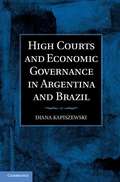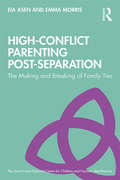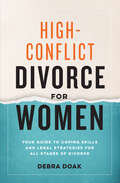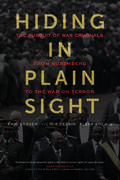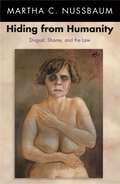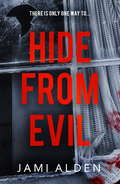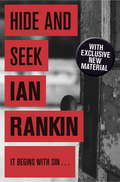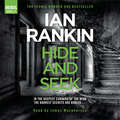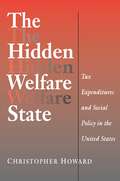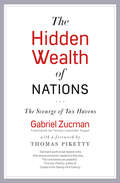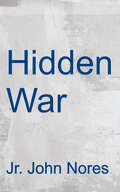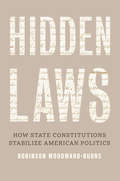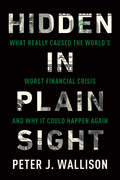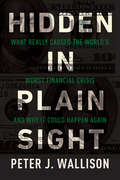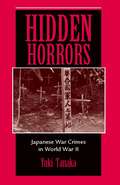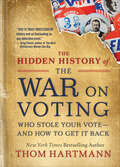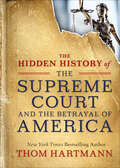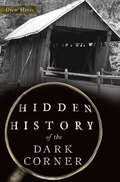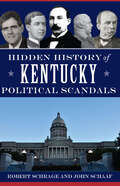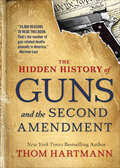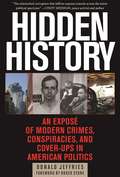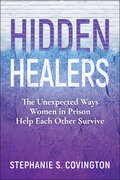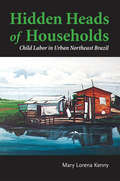- Table View
- List View
High Courts and Economic Governance in Argentina and Brazil
by Diana KapiszewskiHigh Courts and Economic Governance in Argentina and Brazil analyzes how high courts and elected leaders in Latin America interacted over neoliberal restructuring, one of the most significant socioeconomic transformations in recent decades. Courts face a critical choice when deciding cases concerning national economic policy, weighing rule of law concerns against economic imperatives. Elected leaders confront equally difficult dilemmas when courts issue decisions challenging their actions. Based on extensive fieldwork in Argentina and Brazil, this study identifies striking variation in inter-branch interactions between the two countries. In Argentina, while high courts often defer to politicians in the economic realm, inter-branch relations are punctuated by tense bouts of conflict. Brazilian courts and elected officials, by contrast, routinely accommodate one another in their decisions about economic policy. Diana Kapiszewski argues that the two high courts' contrasting characters - political in Argentina and statesman-like in Brazil - shaped their decisions on controversial cases and conditioned how elected leaders responded to their rulings, channeling inter-branch interactions into persistent patterns.
The High Court, the Constitution and Australian Politics
by Rosalind Dixon George Williams Rosalind Dixon George WilliamsThe High Court, the Constitution and Australian Politics is an in-depth exploration of the relationship between decisions of the High Court and broader political currents in Australia. It begins with an investigation of the patterns and effects of constitutional invalidation and dissent on the High Court over time, and their correlation with political trends and attitudes. It also examines the role of constitutional amendment in expressing popular constitutional understandings in the Australian system. Subsequent chapters focus on the eras marked by the tenure of the Court's 12 Chief Justices, examining Court's decisions in the context of the prevailing political conditions and understandings of each. Together, the chapters canvass a rich variety of accounts of the relationship between constitutional law and politics in Australia, and of how this relationship is affected by factors such as the process of appointment for High Court judges and the Court's explicit willingness to consider political and community values.
High-Conflict Parenting Post-Separation: The Making and Breaking of Family Ties (The Anna Freud National Centre for Children and Families)
by Eia Asen Emma MorrisHigh-Conflict Parenting Post-Separation: The Making and Breaking of Family Ties describes an innovative approach for families where children are caught up in their parents’ acrimonious relationship - before, during and after formal legal proceedings have been initiated and concluded. This first book in a brand-new series by researchers and clinicians at the Anna Freud National Centre for Children and Families (AFNCCF) outlines a model of therapeutic work which involves children, their parents and the wider family and social network. The aim is to protect children from conflict between their parents and thus enable them to have healthy relationships across both ‘sides’ of their family network. High-Conflict Parenting Post-Separation is written for professionals who work with high-conflict families – be that psychologists, psychiatrists, child and adult psychotherapists, family therapists, social workers, children’s guardians and legal professionals including solicitors and mediators, as well as students and trainees in all these different disciplines. The book should also be of considerable interest for parents who struggle with post-separation issues that involve their children.
High-Conflict Divorce for Women: Your Guide to Coping Skills and Legal Strategies for All Stages of Divorce
by Debra DoakEmpowering strategies for women negotiating a difficult divorce The only way to get over it is to get through it. Help is here. High-Conflict Divorce for Women has everything that divorce books for women should have—practical strategies, helpful scripts, and realistic advice on how to navigate and cope with a difficult divorce. From understanding the legalities of divorce, to developing a post-divorce budget, and more, this book goes beyond other divorce books for women to offer a wide range of strategies for getting through each stage of the process. Plus, you'll discover tips for emotional and physical self-care, as well as ways to mitigate stress. All divorce books for women should contain information about: Traversing the courts—Find information for handling divorce court, from what to expect to how to present yourself. Knowing what to say—Get scripts for tough situations—including tactful answers to questions from family and colleagues—that you may not find in other divorce books for women. Caring for your kids—From explaining divorce to your children to making a co-parenting plan, learn how to maintain healthy parenting skills during this trying time. Look no further for divorce books for women that help you cope with a difficult divorce—High-Conflict Divorce for Women has you covered.
Hiding in Plain Sight
by Alexa Koenig Victor Peskin Eric StoverHiding in Plain Sight tells the story of the global effort to apprehend the world's most wanted fugitives. Beginning with the flight of tens of thousands of Nazi war criminals and their collaborators after World War II, then moving on to the question of justice following the recent Balkan wars and the Rwandan genocide, and ending with the establishment of the International Criminal Court and America's pursuit of suspected terrorists in the aftermath of 9/11, the book explores the range of diplomatic and military strategies--both successful and unsuccessful--that states and international courts have adopted to pursue and capture war crimes suspects. It is a story fraught with broken promises, backroom politics, ethical dilemmas, and daring escapades--all in the name of international justice and human rights.Hiding in Plain Sight is a companion book to the public television documentary Dead Reckoning: Postwar Justice from World War II to The War on Terror. For more information about the documentary, visit www.saybrookproductions.com. For information about the Human Rights Center, visit hrc.berkeley.edu.
Hiding from Humanity: Disgust, Shame, and the Law
by Martha C. NussbaumShould laws about sex and pornography be based on social conventions about what is disgusting? Should felons be required to display bumper stickers or wear T-shirts that announce their crimes? This powerful and elegantly written book, by one of America's most influential philosophers, presents a critique of the role that shame and disgust play in our individual and social lives and, in particular, in the law. Martha Nussbaum argues that we should be wary of these emotions because they are associated in troubling ways with a desire to hide from our humanity, embodying an unrealistic and sometimes pathological wish to be invulnerable. Nussbaum argues that the thought-content of disgust embodies "magical ideas of contamination, and impossible aspirations to purity that are just not in line with human life as we know it." She argues that disgust should never be the basis for criminalizing an act, or play either the aggravating or the mitigating role in criminal law it currently does. She writes that we should be similarly suspicious of what she calls "primitive shame," a shame "at the very fact of human imperfection," and she is harshly critical of the role that such shame plays in certain punishments. Drawing on an extraordinarily rich variety of philosophical, psychological, and historical references--from Aristotle and Freud to Nazi ideas about purity--and on legal examples as diverse as the trials of Oscar Wilde and the Martha Stewart insider trading case, this is a major work of legal and moral philosophy.
Hide From Evil: Dead Wrong Book 2 (Dead Wrong)
by Jami AldenJami Alden's Hide From Evil will have you on the edge of your seat with its knife edge suspense and sizzling passion. Perfect for fans of Melinda Leigh, Kendra Elliot, Karen Rose and Laura Griffin.Sean Flynn should feel lucky he's alive. But a betrayal by a close friend - and two years on death row - has left him feeling only numb. His conviction overturned, Sean retreats to a quiet cabin where he tries to forget the past. But then she shows up. Deputy Prosecuting Attorney Krista Slater can't forgive herself for convicting an innocent man. But when another brutal murder reveals chilling, new facts about his case, she must turn to Sean for help. Shadowed by danger, and trying to resist the unexpected passion flaring between them, Sean and Krista uncover a twisted maze of deception under the gaze of a cunning mastermind who will do whatever it takes to keep his evil secrets safe.Don't miss more edge-of-the-seat suspense from Jami Alden with her sexy, thrilling novels Beg For Mercy, Run From Fear and Guilty As Sin.
Hide And Seek (A Rebus Novel)
by Ian RankinThe second Inspector Rebus novel from the No.1 bestselling author of A SONG FOR THE DARK TIMES.'Ian Rankin is a genius' Lee ChildA junkie lies dead in an Edinburgh squat, spreadeagled, cross-like on the floor, between two burned-down candles, a five-pointed star daubed on the wall above. Just another dead addict - until John Rebus begins to chip away at the indifference, treachery, deceit and sleaze that lurks behind the facade of the Edinburgh familiar to tourists.Only Rebus seems to care about a death which looks more like a murder every day, about a seductive danger he can almost taste, appealing to the darkest corners of his mind...
Hide And Seek
by Ian RankinThe second Inspector Rebus novel from the No.1 bestselling author of A SONG FOR THE DARK TIMES.'Ian Rankin is a genius' Lee ChildA junkie lies dead in an Edinburgh squat, spreadeagled, cross-like on the floor, between two burned-down candles, a five-pointed star daubed on the wall above. Just another dead addict - until John Rebus begins to chip away at the indifference, treachery, deceit and sleaze that lurks behind the facade of the Edinburgh familiar to tourists.Only Rebus seems to care about a death which looks more like a murder every day, about a seductive danger he can almost taste, appealing to the darkest corners of his mind...
Hide And Seek: From the Iconic #1 Bestselling Writer of Channel 4’s MURDER ISLAND (A Rebus Novel)
by Ian RankinA junkie lies dead in an Edinburgh squat, spreadeagled, cross-like on the floor, between two burned-down candles, a five-pointed star daubed on the wall above.Just another dead addict - until John Rebus begins to chip away at the indifference, treachery, deceit and sleaze that lurks behind the facade of the Edinburgh familiar to tourists.Only Rebus seems to care about a death which looks more like a murder every day, about a seductive danger he can almost taste, appealing to the darkest corners of his mind...Read by Bill Paterson(p) 1999 Orion Publishing Group
The Hidden Welfare State: Tax Expenditures And Social Policy In The United States
by Christopher HowardHere Christopher Howard analyzes the "hidden" welfare state created by such programs as tax deductions for home mortgage interest and employer-provided retirement pensions, the Earned Income Tax Credit, and the Targeted Jobs Tax Credit. Basing his work on the histories of these four tax expenditures, Howard highlights the distinctive characteristics of all such policies. Tax expenditures are created more routinely and quietly than traditional social programs, for instance, and over time generate unusual coalitions of support. They expand and contract without deliberate changes to individual programs. Howard helps the reader to appreciate the historic links between the hidden welfare state and U. S. tax policy, which accentuate the importance of Congress and political parties. He also focuses on the reasons why individuals, businesses, and public officials support tax expenditures. The Hidden Welfare State will appeal to anyone interested in the origins, development, and structure of the American welfare state. Students of public finance will gain new insights into the politics of taxation. And as policymakers increasingly promote tax expenditures to address social problems, the book offers some sobering lessons about how such programs work.
The Hidden Wealth of Nations: The Scourge of Tax Havens
by Gabriel ZucmanWe are well aware of the rise of the 1% as the rapid growth of economic inequality has put the majority of the world's wealth in the pockets of fewer and fewer. One much-discussed solution to this imbalance is to significantly increase the rate at which we tax the wealthy. But with an enormous amount of the world's wealth hidden in tax havens--in countries like Switzerland, Luxembourg, and the Cayman Islands--this wealth cannot be fully accounted for and taxed fairly. No one, from economists to bankers to politicians, has been able to quantify exactly how much of the world's assets are currently hidden--until now. Gabriel Zucman is the first economist to offer reliable insight into the actual extent of the world's money held in tax havens. And it's staggering. In The Hidden Wealth of Nations, Zucman offers an inventive and sophisticated approach to quantifying how big the problem is, how tax havens work and are organized, and how we can begin to approach a solution. His research reveals that tax havens are a quickly growing danger to the world economy. In the past five years, the amount of wealth in tax havens has increased over 25%--there has never been as much money held offshore as there is today. This hidden wealth accounts for at least $7. 6 trillion, equivalent to 8% of the global financial assets of households. Fighting the notion that any attempts to vanquish tax havens are futile, since some countries will always offer more advantageous tax rates than others, as well the counter-argument that since the financial crisis tax havens have disappeared, Zucman shows how both sides are actually very wrong. In The Hidden Wealth of Nations he offers an ambitious agenda for reform, focused on ways in which countries can change the incentives of tax havens. Only by first understanding the enormity of the secret wealth can we begin to estimate the kind of actions that would force tax havens to give up their practices. Zucman's work has quickly become the gold standard for quantifying the amount of the world's assets held in havens. In this concise book, he lays out in approachable language how the international banking system works and the dangerous extent to which the large-scale evasion of taxes is undermining the global market as a whole. If we are to find a way to solve the problem of increasing inequality, The Hidden Wealth of Nations is essential reading.
Hidden War: How Special Operations Game Wardens are Reclaiming America's Wildlands from the Drug Cartels
by Jr. John NoresDANGER On Your Public Lands! Death stalks America's wildlands. Indiscriminate destroyers of people, wildlife, and the environment, cartel marijuana growers will do anything to supply the black-market demand for weed. HIDDEN WAR, 2nd Edition, exposes this threat, give you a rare, inside glimpse into the operations of specially trained tactical teams with the California Department of Fish & Wildlife to infiltrate and take down these groups. In this updated and revised second edition of his popular 2019 book, Lt. John Nores, Jr., provides a sobering look at crimes against people and the environment on public lands as clandestine crime organizations and special forces game wardens go to war in a struggle that cuts across political ideologies about marijuana legalization.
Hidden Laws: How State Constitutions Stabilize American Politics
by Robinson Woodward-BurnsHow state constitutional reform guides and stabilizes American constitutional and political development State constitution reform guides and stabilizes American constitutional and political development. Using data sets and historical case studies, Robinson Woodward‑Burns shows how the federal government has repeatedly deferred to state constitutional reform to manage or address difficult national constitutional controversies, including conflicts over the regulation of slavery, banking and taxation, women&’s suffrage, labor and welfare rights, voting and civil rights, and gender discrimination.
Hidden in Plain Sight: What Really Caused the World's Worst Financial Crisisand Why It Could Happen Again
by Peter J. WallisonThe 2008 financial crisis-like the Great Depression-was a world-historical event. What caused it will be debated for years, if not generations. The conventional narrative is that the financial crisis was caused by Wall Street greed and insufficient regulation of the financial system. That narrative produced the Dodd-Frank Act, the mostcomprehensive financial-system regulation since the New Deal. There is evidence, however, that the Dodd-Frank Act has slowed the recovery from the recession. If insufficient regulation caused the financial crisis, then the Dodd-Frank Act will never be modified or repealed; proponents will argue that doing so will cause another crisis.A competing narrative about what caused the financial crisis has received little attention. This view, which is accepted by almost all Republicans in Congress and most conservatives, contends that the crisis was caused by government housing policies. This book extensively documents this view. For example, it shows that in June 2008, before the crisis, 58 percent of all US mortgages were subprime or other low-quality mortgages. Of these, 76 percent were on the books of government agencies such as Fannie Mae and Freddie Mac. When these mortgages defaulted in 2007 and 2008, they drove down housing prices and weakened banks and other mortgage holders, causing the crisis.After this book is published, no one will be able to claim that the financial crisis was caused by insufficient regulation, or defend Dodd-Frank, without coming to terms with the data this book contains.
Hidden in Plain Sight
by Peter J. WallisonThe 2008 financial crisis-like the Great Depression-was a world-historical event. What caused it will be debated for years, if not generations. The conventional narrative is that the financial crisis was caused by Wall Street greed and insufficient regulation of the financial system. That narrative produced the Dodd-Frank Act, the most comprehensive financial-system regulation since the New Deal. There is evidence, however, that the Dodd-Frank Act has slowed the recovery from the recession. If insufficient regulation caused the financial crisis, then the Dodd-Frank Act will never be modified or repealed; proponents will argue that doing so will cause another crisis.A competing narrative about what caused the financial crisis has received little attention. This view, which is accepted by almost all Republicans in Congress and most conservatives, contends that the crisis was caused by government housing policies. This book extensively documents this view. For example, it shows that in June 2008, before the crisis, 56 percent of all US mortgages were subprime or otherwise low-quality. Of these, 76 percent were on the books of government agencies such as Fannie Mae and Freddie Mac. When these mortgages defaulted in 2007 and 2008, they drove down housing prices and weakened banks and other mortgage holders, causing the crisis.After this book is published, no one will be able to claim that the financial crisis was caused by insufficient regulation, or defend Dodd-Frank, without coming to terms with the data this book contains.
Hidden Horrors
by Yuki TanakaThis book documents for the first time previously hidden Japanese atrocities in World War II, including cannibalism; the slaughter and starvation of prisoners of war; the rape, enforced prostitution, and murder of noncombatants; and biological warfare experiments. The author describes how desperate Japanese soldiers consumed the flesh of their own comrades killed in fighting as well as that of Australians, Pakistanis, and Indians. Another chapter traces the fate of 65 shipwrecked Australian nurses and British soldiers who were shot or stabbed to death by Japanese soldiers. Thirty-two other nurses, who landed on another island, were captured and sent to Sumatra to become "comfort women”--prostitutes for Japanese soldiers. Tanaka recounts how thousands of Australian and British POWs died in the infamous Sandakan camp in the Borneo jungle in 1945. Those who survived were forced to endure a tortuous 160-mile march on which anyone who dropped out of line was immediately shot. Only six escapees lived to tell the tale. Based on exhaustive research in previously closed archives, this book represents a landmark analysis of Japanese war crimes. The author explores individual atrocities in their broader social, psychological, and institutional milieu and places Japanese behavior during the war in the broader context of the dehumanization of men at war--without denying individual and national responsibility.
The Hidden History of the War on Voting: Who Stole Your Vote—and How To Get It Back (The\thom Hartmann Hidden History Ser. #3)
by Thom Hartmann"Hartmann's history of voter suppression in America is necessary information given current news about voter registration purges and redistricting...a particularly timely topic for an election year, and anyone who is seriously concerned about the survival of American democracy will want to read this book and apply its lessons."—BooklistAmerica's #1 progressive radio host looks at how elites have long tried to disenfranchise citizens—particularly people of color, women, and the poor—and shows what we can do to ensure everyone has a voice in this democracy.In today's America, only a slim majority of people register to vote, and a large percentage of registered voters don't bother to show up: Donald Trump was elected by only 26 percent of eligible voters. Unfortunately, this is not a bug in our system, it's a feature. Thom Hartmann unveils the strategies and tactics that conservative elites in this country have used, from the foundation of the Electoral College to the latest voter ID laws, to protect their interests by preventing &“the wrong people&”—such as the poor, women, and people of color—from voting while making it more convenient for the wealthy and white. But he also lays out a wide variety of simple, commonsense ways that we the people can fight back and reclaim our right to rule through the ballot box.
The Hidden History of the Supreme Court and the Betrayal of America: 8 Superpowers for Thriving in Constant Change (The\thom Hartmann Hidden History Ser. #2)
by Thom Hartmann&“Hartmann delivers a full-throated indictment of the U.S. Supreme Court in this punchy polemic." —Publishers WeeklyThom Hartmann, the most popular progressive radio host in America and a New York Times bestselling author, explains how the Supreme Court has spilled beyond its Constitutional powers and how we the people should take that power back.Taking his typically in-depth, historically informed view, Thom Hartmann asks, What if the Supreme Court didn't have the power to strike down laws? According to the Constitution, it doesn't. From the founding of the republic until 1803, the Supreme Court was the final court of appeals, as it was always meant to be. So where did the concept of judicial review start? As so much of modern American history, it began with the battle between the Federalists and Anti-Federalists, and with Marbury v. Madison. Hartmann argues it is not the role of the Supreme Court to decide what the law is but rather the duty of the people themselves. He lays out the history of the Supreme Court of the United States, since Alexander Hamilton's defense to modern-day debates, with key examples of cases where the Supreme Court overstepped its constitutional powers. The ultimate remedy to the Supreme Court's abuse of power is with the people--the ultimate arbiter of the law--using the ballot box. America does not belong to the kings and queens; it belongs to the people.
Hidden History of the Dark Corner (Hidden History)
by Drew HinesThe "Dark" in the Dark Corner Years ago, when travelers to northern Greenville County asked a local where the Dark Corner was, invariably their reply was, "Just a little further up the road." In those days few people wanted to admit they lived in that much storied and much maligned part of the county known as the Dark Corner. The Dark Corner in those days was legendary for its moonshine, murder and mayhem. This is the story of that well-known region. We travel back to the Dark Corner's earliest days when its only human inhabitants were the Cherokee, and we move into the present where horse farms and multi-million-dollar homes dot the countryside that once contained moonshine stills and cornfields.
Hidden History of Kentucky Political Scandals
by Robert Schrage John SchaafeA wild journey through the shady side of Bluegrass politics, from bribe-takers to traitors to treasury raiders. In 1826, Governor Desha pardoned his own son for murder. In a horrific crime, Governor Goebel was assassinated in 1900. James Wilkinson was branded a traitor against Kentucky and the nation. &“Honest Dick Tate&” ran away with massive amounts of money from the state treasury. And in modern times, Operation BOPTROT resulted in perhaps the biggest scandal in the state. At various points in history, Kentucky&’s politics and government have been rocked by scandal, and each episode defined the era in which it happened. In this book, Robert Schrage and John Schaaf offer a fascinating account of Kentucky&’s history and its many unique and scandalous characters. Includes photographs
The Hidden History of Guns and the Second Amendment: How to Talk about Race, Religion, Politics, and Other Polarizing Topics (The\thom Hartmann Hidden History Ser. #1)
by Thom Hartmann&“In this precise primer on firearms practices and policies, progressive talk-show host Hartmann examines the history of routine gun usage and extreme gun violence and assesses the influence of gun ownership on contemporary political, economic, and social norms…A brief but powerful analysis of a searing national crisis.&” —BooklistThom Hartmann, the most popular progressive radio host in America and a New York Times bestselling author, looks at the real history of guns in America and what we can do to limit both their lethal impact and the power of the gun lobby. Taking his typically in-depth, historically informed view, Hartmann examines the brutal role guns have played in American history, from the genocide of the Native Americans to the enforcement of slavery (Slave Patrols are in fact the Second Amendment's &“well-regulated militias&”) and the racist post–Civil War social order. He shows how the NRA and conservative Supreme Court justices used specious logic to invent a virtually unlimited individual right to own guns, which has enabled the ever-growing number of mass shootings in the United States. But Hartmann also identifies a handful of powerful, commonsense solutions that would break the power of the gun lobby and restore the understanding of the Second Amendment that the Framers of the Constitution intended. This is the kind of brief, brilliant analysis for which Hartmann is justly renowned.
Hidden History: An Exposé of Modern Crimes, Conspiracies, and Cover-Ups in American Politics
by Roger Stone Donald JeffriesThe US government has spent as much time covering up conspiracies as it has helping the American people. In Hidden History, you will see the amount of effort that our government has dedicated over the past fifty years to lying and covering up the truth to the world.Starting with the assassination of President John F. Kennedy, Don Jeffries chronicles a wide variety of issues that have plagued our country's history. Whether it is the assassinations of MLK and RFK, Iran-Contra, the Oklahoma City bombing, TWA Flight 800, voting fraud, or 9/11, every major disaster or war that we've sitnessed has somehow been distorted by those who are supposed to be protecting us. Jeffries also delves into extensive research on the death of John F. Kennedy, Jr. - and what he finds will shock you.So whether you've only heard bits and pieces of these stories or you've read several books on the topics, Hidden History is the book that belongs in every conspiracy theorist's library, as the information included here has never been collected together in any other published work available. So sit down, strap in, and get ready to be shocked and awed by how much has been hidden by our government over the past fifty years. Updated for 2016, this version features a new introduction by political insider Roger Stone.
Hidden Healers: The Unexpected Ways Women in Prison Help Each Other Survive
by Stephanie S. CovingtonA gripping and deeply-felt examination of incarcerated women's lives With unflinching clarity, Hidden Healers cuts through the myths about incarcerated women to expose the all-too-real brutalities they face within a criminal legal system never designed for them. Backed by three decades' experience providing therapeutic programs inside prisons across the United States, trauma specialist Dr. Stephanie Covington has used her unique access to amplify the voices of the women themselves. Their stories illuminate realities most never see: that most women who get caught up in the criminal justice system have themselves been victims of harm, that the degradations of today's prisons and jails only magnify their trauma- and that incarcerated women regularly risk punishment to tend to one another's well-being in unexpected acts of kindness. Grounded in research and rich with personal narrative, Hidden Healers is a poignant and riveting look inside women's prisons and jails- and what we can do to help.
Hidden Heads of Households: Child Labor In Urban Northeast Brazil (Teaching Culture: Utp Ethnographies For The Classroom Ser.)
by Mary Lorena KennyIn the cities of Northeast Brazil where 50 per cent of the population lives in poverty, children play a key role in the local economy—in their households, in formal jobs, and in the thriving informal sector (washing cars, shining shoes, scavenging for recyclables, etc.). Why children migrate to the city, how they negotiate their existence, and why they stay are just some of the questions addressed in this fascinating study. Mary Kenny spent close to 15 years in the urban areas of Northeast Brazil talking with and interviewing children. She even gave them disposable cameras to document their daily lives (many of the photographs they took are included). Rather than lament a lost childhood, or try to save these children, Kenny explores some of the complex conditions under which these children work and live. She illustrates how unrelenting scarcity shapes family and, by extension, children's options, decisions, and worldviews. The issues raised in this book are of critical importance. There are no easy answers, but listening to how these children define themselves and their circumstances is an important step towards understanding and ultimately solving economic and social inequality.
